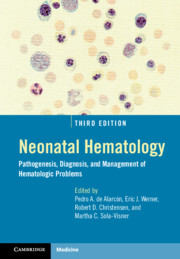Book contents
- Neonatal Hematology
- Neonatal Hematology
- Copyright page
- Contents
- Foreword
- Preface
- Contributors
- Section I Developmental Hematology
- Section II Bone Marrow Failure and Immune Disorders
- Chapter 4 Bone Marrow Failure Syndromes
- Chapter 5 Immunodeficiency Diseases of the Neonate
- Section III Erythrocyte Disorders
- Section IV Platelet Disorders
- Section V Leucocyte Disorders
- Section VI Hemostatic Disorders
- Section VII Neonatal Transfusion Medicine
- Section VIII Neonatal Oncology
- Section IX Miscellaneous
- Index
- Plate Section (PDF Only)
- References
Chapter 5 - Immunodeficiency Diseases of the Neonate
from Section II - Bone Marrow Failure and Immune Disorders
Published online by Cambridge University Press: 30 January 2021
- Neonatal Hematology
- Neonatal Hematology
- Copyright page
- Contents
- Foreword
- Preface
- Contributors
- Section I Developmental Hematology
- Section II Bone Marrow Failure and Immune Disorders
- Chapter 4 Bone Marrow Failure Syndromes
- Chapter 5 Immunodeficiency Diseases of the Neonate
- Section III Erythrocyte Disorders
- Section IV Platelet Disorders
- Section V Leucocyte Disorders
- Section VI Hemostatic Disorders
- Section VII Neonatal Transfusion Medicine
- Section VIII Neonatal Oncology
- Section IX Miscellaneous
- Index
- Plate Section (PDF Only)
- References
Summary
Understanding the development of specific components of the neonatal immune system is critical to the understanding of the susceptibility of the neonate to specific pathogens [1]. With the increasing survival of extremely premature infants, neonatologists and other physicians caring for these newborns need to be aware of the vulnerability of this population. Furthermore, it is important for neonatologists to be able to differentiate between immune immaturity and the manifestations of a true primary immunodeficiency that present during the neonatal period. Failure to properly identify primary or acquired immunodeficiency diseases can result in delayed diagnosis and treatment, adversely affecting outcomes. This chapter will briefly define the immune immaturity of the neonate and a diagnostic approach for primary immune deficiency diseases that may present in the neonatal period.
- Type
- Chapter
- Information
- Neonatal HematologyPathogenesis, Diagnosis, and Management of Hematologic Problems, pp. 62 - 92Publisher: Cambridge University PressPrint publication year: 2021



